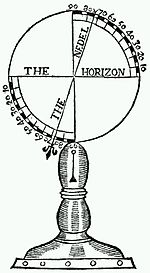- Magnetic dip
-
Magnetic dip or magnetic inclination is the angle made by a compass needle with the horizontal at any point on the Earth's surface. Positive values of inclination indicate that the field is pointing downward, into the Earth, at the point of measurement. The value can be measured with a dip circle.
Dip angle was discovered by Shen Kuo in the 11th century, who recorded his discovery in his Dream Pool Essays.[citation needed] It was first described in Europe by Georg Hartmann in 1544.
Contents
Explanation
 Isoclinic lines for the year 2010.
Isoclinic lines for the year 2010.
Magnetic dip results from the tendency of a magnet to align itself with lines of force. As the Earth's magnetic lines of force are not parallel to the surface, the north end of a compass needle will point downward on the northern hemisphere (positive dip) or upward on the southern hemisphere (negative dip). Contour lines along which the dip measured at the Earth's surface is equal are referred to as isoclinic lines. The locus of the points having zero dip is called the magnetic equator or aclinic line.[1] The range of dip is from -90 degrees to 90 degrees.
Importance
The phenomenon is especially important in aviation, as it causes the airplane's compass to give erroneous readings during banked turns and airspeed changes.
See also
References
- ^ James Wood, ed (1907) [1900]. "Aclinic Line". The Nuttall Encyclopædia (1907 ed.). http://www.fromoldbooks.org/Wood-NuttallEncyclopaedia/a/aclinicline.html.
External links
Categories:- Geomagnetism
- Orientation
- Aviation stubs
- Geophysics stubs
Wikimedia Foundation. 2010.

